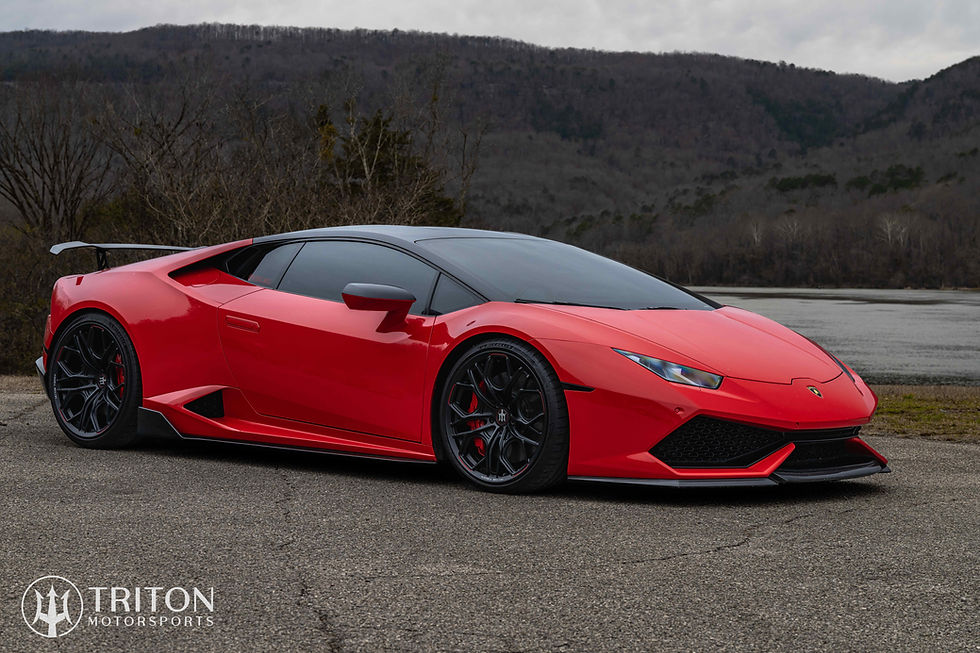Best Tire Compounds for Track and Street Driving (2025 Guide)
- Triton Motorsports

- 2 days ago
- 4 min read
Introduction – Why Tire Compound Matters
When people talk about upgrading performance cars, the conversation usually revolves around brakes, wheels, and suspension. But the truth is simple: none of that matters if your tires can’t put the power down.
Your tire compound — the chemical blend of rubber, resins, and reinforcing agents — determines grip, heat resistance, wear rate, and overall performance. Get it right, and your car feels planted, responsive, and confidence-inspiring. Get it wrong, and even the most advanced floating steel rotors, carbon ceramic brakes, or forged wheels won’t save you from unpredictable handling.
In this guide, we’ll compare street tires, ultra-high-performance tires, R-compounds, and slicks, explain the science of tire compounds, and help you choose the right option for your driving style.

The Science of Tire Compounds
A tire compound is a carefully engineered blend of:
Natural and synthetic rubber – provides flexibility and grip.
Carbon black and silica – improve wear resistance and wet traction.
Resins and oils – adjust stickiness and heat behavior.
The softer the compound, the more grip it provides — but at the cost of faster wear. Harder compounds last longer, but sacrifice outright traction.
Think of it as a triangle of compromise:
Grip
Longevity
Comfort/Noise
You can maximize two, but rarely all three.
Street Performance Compounds
Characteristics
Balanced for grip, comfort, and longevity.
Designed to work in wide temperature ranges.
Tread optimized for wet and dry traction.
Examples
Michelin Pilot Sport 4S
Continental ExtremeContact Sport
Pirelli P Zero (street versions)
Best Use Cases
Daily-driven cars that see occasional spirited driving.
Owners who want quiet, comfortable ride quality with reliable grip.
Pairing with Triton Products
Street compounds pair perfectly with Triton floating steel rotors and semi-metallic pads for cars like the BMW M3/M4 or Audi RS6. They provide a great balance without overwhelming the tire during spirited driving.
Ultra-High-Performance Compounds
Characteristics
Softer than standard street tires, stickier in warm temps.
Reduced tread life (15,000–25,000 miles typical).
Louder, stiffer ride.
Examples
Michelin Pilot Sport Cup 2
Bridgestone Potenza Sport
Toyo Proxes Sport
Best Use Cases
Weekend performance cars.
Spirited canyon driving.
Occasional HPDE (high-performance driver events).
Pairing with Triton Products
These tires come alive when combined with forged wheels (to reduce weight) and carbon ceramic conversion kits. The heat resistance of carbon ceramics ensures fade-free braking to match the higher grip levels of these compounds.
R-Compound Tires
Characteristics
Semi-slick tread design.
Extremely sticky rubber designed for track use.
Optimal only within specific heat ranges.
Short lifespan (5,000–8,000 miles).
Examples
Toyo R888R
Nitto NT01
Michelin Pilot Sport Cup 2 R
Best Use Cases
Dedicated track cars that still drive on the street.
Enthusiasts chasing lap times.
Pairing with Triton Products
R-compounds demand maximum braking power and precise wheel fitment. Our floating steel rotors or CCB-H carbon ceramics combined with forged wheels ensure reduced unsprung mass, faster heat dissipation, and full advantage of the grip R-compounds provide.
Racing Slicks
Characteristics
No tread — 100% contact patch.
Designed for track-only use.
Extremely high grip but useless in wet or cold conditions.
Very short lifespan (often measured in hours).
Examples
Pirelli P Zero Slicks
Hoosier Racing Slicks
Best Use Cases
Full race cars only.
Not DOT legal for street use.
Pairing with Triton Products
On racing slicks, only fully forged wheels make sense. The strength-to-weight ratio ensures durability under extreme loads, while CCB-H carbon ceramic brakes provide fade-free braking in long sessions.
Flow-Formed Marketing vs. Forged Precision in Tires and Wheels
Just like wheel companies that disguise flow-formed cast wheels as “forged,” tire marketing often hides compromises. Some “track-inspired street tires” sound like slicks but perform more like firm street compounds.
This is why enthusiasts who care about authentic performance invest in forged wheels and true performance tires matched to their use case, rather than buying into marketing hype.
Comparison Chart – Tire Compounds
Compound Type | Grip | Longevity | Wet Performance | Best Use Case |
Street | Good | High | Excellent | Daily + spirited |
Ultra-High-Perf | Very Good | Moderate | Good | Weekend + occasional track |
R-Compound | Excellent | Low | Poor | Track days, lap times |
Slicks | Extreme | Very Low | None | Racing only |
FAQs
Q: What’s the best tire compound for daily driving?
A: A street performance compound like Michelin Pilot Sport 4S offers the best balance.
Q: Do I need carbon ceramic brakes for street tires?
A: Not necessary. Floating steel rotors are ideal with street compounds.
Q: Can I daily drive on R-compounds?
A: Possible, but not recommended — they wear quickly and perform poorly in rain.
Q: What about cold-weather performance?
A: Summer performance compounds harden in cold temps. For year-round use, consider all-season compounds instead.
Conclusion – Build the Complete Package
Choosing the right tire compound isn’t just about grip — it’s about matching your brakes, wheels, and driving goals.
Daily drivers → Street compounds + floating steel rotors.
Weekend cars → Ultra-high-performance tires + forged wheels.
Track toys → R-compounds or slicks + carbon ceramic brakes + forged wheels.
At Triton Motorsports, we provide the floating steel rotors, Gen 3 CCB-H carbon ceramics, and forged wheels that allow your tires to perform at their peak. Tires are the final link between your upgrades and the asphalt — make sure they’re matched to the right hardware.




Comments